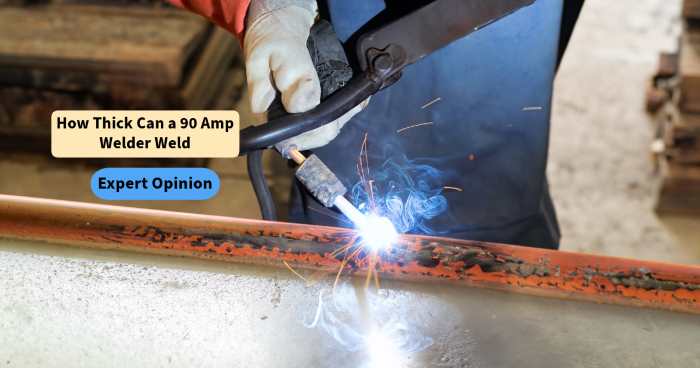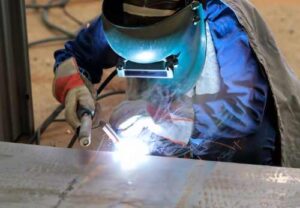Table of Contents
- How Thick Can a 90 Amp Welder Weld?
- Factors Affecting Welding Thickness
- Choosing the Right Electrode
- Preparation and Safety Measures
- Welding Techniques for Thicker Materials
- Common Welding Defects and How to Avoid Them
- Tips for Successful Welding with a 90 Amp Welder
- Pushing the Limits: Pushing Beyond 90 Amps
- Advantages of Using a 90 Amp Welder
- Comparing 90 Amp Welders to Higher Amp Welders
- Applications of Welding with a 90 Amp Welder
- Maintenance and Care of Your Welder
- Upgrading Your Welder: When It’s Necessary
- Exploring Other Welding Methods
- Exploring Common FAQs about 90 Amp Welders:
- Can a 90-amp welder handle automotive repairs?
- What safety precautions should I take while welding with a 90-amp welder?
- Is preheating necessary for thicker materials?
- Can I weld stainless steel with a 90-amp welder?
- How do I avoid weld distortion?
- What’s the thickest material I can weld with a 90 amp welder?
- Conclusion:
Welding is a fundamental process in metal fabrication, construction, and various industries. One common question that arises for welding enthusiasts is, “How thick can a 90-amp welder weld?” In this article, we will explore the capabilities of a 90-amp welder, providing detailed information, insights, and practical advice. Whether you’re a novice or an experienced welder, understanding the limits of your equipment is crucial for achieving quality welds.
How Thick Can a 90 Amp Welder Weld?
A 90-amp welder is a versatile tool that can handle various metal thicknesses. The thickness a 90 amp welder can weld depends on several factors, including the welding process, type of metal, joint design, and the skill of the welder. Let’s break down the different aspects to give you a clear picture:
Welding Processes and Their Impact on Thickness
Different welding processes, such as MIG (Metal Inert Gas), TIG (Tungsten Inert Gas), and Stick welding, have varying capabilities when it comes to metal thickness. A 90 amp MIG welder, can typically handle metal thicknesses ranging from 1/8 inch to 1/4 inch, while a TIG welder can achieve high-quality welds on thinner materials.
Factors Affecting Welding Thickness
The thickness a 90 amp welder can handle is influenced by multiple factors, including:
1. Welding Material
Different materials conduct heat differently. Thicker materials require more heat input to achieve a strong weld. Mild steel, stainless steel, and aluminum have varying heat conductivity, affecting welding outcomes.
2. Electrode Size
Electrodes come in various sizes, and their thickness can impact the weld penetration. Thicker electrodes can handle more current, affecting the overall weld quality.
3. Joint Preparation
Properly cleaning and preparing the joint surface ensures better penetration and stronger welds. Inadequate preparation can lead to weaker joints and reduced welding thickness.
4. Welding Position
Welding in different positions (flat, horizontal, vertical, overhead) affects heat distribution and penetration, influencing the thickness the welder can handle.
5. Amperage and Voltage Settings
Adjusting the amperage and voltage settings on the welder can impact the quality of the weld. Higher settings can handle thicker materials, but finding the right balance is crucial.
Choosing the Right Electrode
Selecting the appropriate electrode is essential for achieving optimal results with a 90-amp welder. Electrodes with a higher diameter can handle more heat and provide better penetration for thicker materials.
Preparation and Safety Measures
Before starting any welding project, safety is paramount. Ensure proper ventilation, wear protective gear, and follow safety guidelines to prevent accidents and injuries.
Welding Techniques for Thicker Materials
Welding thicker materials requires specific techniques. Employing a weaving motion and using multiple passes can help achieve better penetration and a stronger weld.
Common Welding Defects and How to Avoid Them
Welding defects like porosity, undercutting, and lack of fusion can weaken the joint. Proper technique, amperage settings, and electrode choice can help avoid these issues.
Tips for Successful Welding with a 90 Amp Welder
- Maintain a steady hand and consistent travel speed.
- Practice on scrap pieces before tackling important projects.
- Monitor your weld bead and adjust settings if needed.
Pushing the Limits: Pushing Beyond 90 Amps
While a 90 amp welder is designed for certain thicknesses, pushing the limits might be possible with careful adjustments. However, this can impact weld quality and safety.
Advantages of Using a 90 Amp Welder
- Portability and ease of use.
- Suitable for light to moderate welding tasks.
- Requires less power consumption.
Comparing 90 Amp Welders to Higher Amp Welders
Higher amp welders can handle thicker materials, but they might not be as portable or cost-effective as a 90 amp welder. Choosing the right welder depends on your specific needs.
Applications of Welding with a 90 Amp Welder
- DIY projects and home repairs.
- Automotive maintenance.
- Light fabrication work.
Maintenance and Care of Your Welder
Regular maintenance and cleaning prolong the lifespan of your welder. Keep electrodes dry, clean the machine, and address any issues promptly.
Upgrading Your Welder: When It’s Necessary
As your welding projects become more complex, upgrading to a higher amp welder might be necessary. Evaluate your requirements and invest in equipment that suits your needs.
Exploring Other Welding Methods
While a 90 amp welder serves various purposes, exploring other welding methods like MIG or TIG expands your capabilities and opens doors to more intricate projects.
How Thick Can You Weld at 90 Amps?
Welding at 90 amps offers a respectable range of capabilities when it comes to metal thickness. Generally, with this amperage, you can effectively weld metal sheets that are around 1/8 inch thick. It’s important to note that while 90 amps can handle this thickness, the quality of the weld also depends on other factors such as joint preparation, welding technique, and the type of electrode used.
Determining the Thickness of an 80 Amp Welder
An 80-amp welder is specifically designed for lighter welding tasks and materials. When operating with an 80 amp welder, you can confidently work with metal sheets up to approximately 3/32 inch in thickness. This amperage range is particularly suitable for projects that require precision and finesse due to the lower heat input.
Exploring the Capabilities of a 100 Amp Welder
Stepping up to a 100 amp welder unlocks greater versatility in terms of metal thickness. This amperage level enables you to weld metal sheets with a thickness of up to 1/4 inch. As the amperage increases, so does the heat input, allowing for stronger welds on thicker materials.
Amp Requirements for Welding 1-Inch Steel
Welding steel that is 1 inch thick demands higher amperage to achieve proper fusion and penetration. In most cases, you would need around 200 to 250 amps to weld 1-inch steel effectively. This higher amperage provides the necessary heat to melt the thicker metal and create a robust weld.
Exploring Common FAQs about 90 Amp Welders:
Can a 90-amp welder handle automotive repairs?
Absolutely! A 90-amp welder can tackle automotive repairs effectively. It’s suitable for welding thinner sheets of metal commonly found in car bodies.
What safety precautions should I take while welding with a 90-amp welder?
Safety is paramount when welding. Always wear appropriate protective gear, such as a welding helmet, gloves, and flame-resistant clothing. Make sure you’re in a place with good airflow to avoid breathing in any fumes.
Is preheating necessary for thicker materials?
Preheating can be beneficial for thicker materials, as it helps reduce the risk of cracking. However, for materials within the range of a 90-amp welder, preheating might not be necessary.
Can I weld stainless steel with a 90-amp welder?
Yes, you can weld stainless steel with a 90-amp welder. However, stainless steel requires specific techniques and consumables to achieve strong, clean welds.
How do I avoid weld distortion?
To minimize weld distortion, use proper tacking techniques, avoid excessive heat buildup, and use a sequence that balances the welding process across the joint.
What’s the thickest material I can weld with a 90 amp welder?
While a 90 amp welder can handle materials up to 1/4 inch thick, it’s recommended to stay within its optimal range of around 1/8 inch for consistent results.
Conclusion:
In conclusion, a 90-amp welder can handle welding tasks with a certain thickness range, influenced by factors like welding material, electrode size, joint preparation, and technique. By understanding these variables and employing the right techniques, you can achieve successful welds and expand your welding capabilities. Remember to prioritize safety and regular maintenance for consistent and reliable results.

